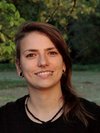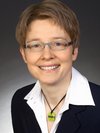Summary
Clay is one of the possible host rocks for a repository for highly radioactive waste. Experiments have already shown that Opalinus Clay, for example, has a very good retention capacity for radionuclides such as uranium. However, they only reflect the real geochemical conditions of long-term storage to a limited extent. With the help of numerical simulations, Theresa Hennig and Michael Kühn, both from the GFZ German Research Centre for Geosciences in Potsdam and the University of Potsdam, have shown for the first time how the temporally and spatially variable pore water geochemistry in claystone affects the sorption and transport conditions of radionuclides. Although according to the new models a stronger migration of uranium over a few tens of metres is to be expected, if the host rock has a thickness of at least 100 metres, as required by the German Site Selection Act, centrally introduced uranium is effectively retained from the adjacent aquifers in this case even after a million years. The study was published in the journal Minerals. Now Hennig has been awarded a doctorate for her work on this topic.
Background: Search for a repository
The search for a suitable host rock is an important basis for a nuclear repository in which highly radioactive waste is to be safely sealed for more than a million years. Besides crystalline rock such as granite or rock salt, claystone is also one of the possible formations. Opalinus Clay, as it occurs in Switzerland and Germany, has a very good retention capacity for radionuclides, i.e. radioactive substances such as uranium, which are contained to a high degree in spent fuel rods from nuclear power plants, for example. Furthermore, claystones are hardly permeable and only allow diffusive, i.e. very slow, transport through the existing pore space. This has been proven in many laboratories as well as in on-site experiments.
Experiments are not enough
The experiments are usually carried out under constant and geochemically homogeneous experimental conditions. For example, also in the underground research laboratory at Mont Terri in Switzerland.
"For the radionuclide uranium, however, it has been shown, for example, that sorption and diffusion, i.e. the retention capacity and transport in the clay, are strongly influenced by changes in the geochemistry of the pore water," explains Theresa Hennig, first author of the study. This is due to various interactions between the clay mineral surfaces and the ions in the pore water. The claystone is surrounded by aquifers and has been in diffusive exchange with them for millions of years. Due to the therefore altered pore water geochemistry, sorption and diffusion in the host rock can differ by one or more orders of magnitude depending on time and location. Consequently, transport parameters determined selectively in individual experiments cannot be transferred to geochemical conditions at other locations and times under all circumstances.
Numerical simulations indispensable for the safety assessment of potential repositories
Because the spatial and temporal scales to be considered for the safety assessment of potential repositories are very large and very long, numerical simulations are essential to quantify the potential migration of radionuclides. This is because experiments in the laboratory as well as in the field can only ever cover a very small spatial and very short temporal scale.
"The approach we have chosen quantifies for the first time the influence of changing geochemical conditions on the sorption and diffusive transport of uranium on the host rock scale for one million years. This also allows us to make statements about the uncertainty of experimentally determined transport parameters," says Theresa Hennig.
The simulation approach
Hennig and Kühn first simulated the mineralogical and geochemical composition of the Opalinus Clay in its hydrogeological environment, as it corresponds to the conditions at Mont Terri in Switzerland. Another basis was knowledge from the geological development of the area: The Opalinus Clay is embedded between limestones, marls and shales and was only influenced by infiltrating freshwater with the uplift of the Jura Mountains and the subsequent erosion. This results in the required pore water profiles as initial conditions - calibrated with chloride profiles measured on field samples.
Assuming that a potential repository is located in the middle of the clay layer, it was then simulated how uranium migrates under these geochemically heterogeneous conditions over a period of one million years and how thick the claystone must be to serve as a barrier.
With a sufficiently thick layer of claystone, uranium is effectively retained
The results show that under these conditions, uranium migrates on the order of up to 50 metres towards the adjacent aquifer within a million years. This is several tens of metres further than would be observed in a homogeneous system without geochemical gradients. Uranium migration is thus enhanced by variations in geochemistry in the pore water and the formation of concentration gradients. Nevertheless, in this case the uranium does not reach the adjacent aquifers and is thus effectively retained in the potential host rock.
Original study: Hennig, T., Kühn M. (2021): Potential Uranium Migration within the Geochemical Gradient of the Opalinus Clay System at the Mont Terri. Minerals 11, 1087. DOI: 10.3390/min11101087
https://doi.org/10.3390/min11101087
Further information:
System Erde. GFZ-Journal
Issue 2021/02 – Focus: No nuclear waste repository without geology
(German only)
Chapter: Modelle simulieren die Zukunft
Michael Kühn, Theresa Hennig, Oliver Heidbach, Magdalena Scheck-Wenderoth
System Erde, 11(2), pp. 30-35, 2021.
DOI: https://doi.org/10.48440/GFZ.syserde.11.02.5
Summary | Complete Article (PDF 2 MB)


![[Translate to English:] Foto eines Bergs mit darüber gelegter Skizze des geologischen Profils.](/fileadmin/_processed_/0/0/csm_20220819_News_Wirtsgestein_Ton_MontTerri_he_-c-Profil-Henning_Karte-GoogleEarth-LANDSAT-Copernicus_53ac2f1b00.jpeg)








![[Translate to English:] Torsten Sachs in front of a climate station on a field](/fileadmin/_processed_/3/9/csm__TorstenSachs_bearbeitet_GS_4a1365ef84.jpeg)

![[Translate to English:] left image flood at the Ahrtal: image from above, several houses are flooded; left image:: Heidi Kreibich;](/fileadmin/_processed_/4/4/csm_Bild2_9af0130e9f.png)



![[Translate to English:] Start der Vega Rakete](/fileadmin/_processed_/6/4/csm_20231201-kachel_Vega-VV23-launch_ESA-CNES-Arianespace_706716b68c.jpeg)









![[Translate to English:] Poster exhibition at the Brandenburg Hydrogen Day at the GFZ, some participants in the foreground](/fileadmin/_processed_/6/5/csm_Erster_Brandenburgischer_Wasserstofftag_GFZ_402fcec95e.jpeg)
![[Translate to English:] Group picture of the participants](/fileadmin/_processed_/9/4/csm_20231108_CAWa-Workshop-Tashkent_Gruppenbild_99ea779d8a.jpeg)

![[Translate to English:] [Translate to English:] Hörsaal](/fileadmin/_processed_/e/6/csm_H%C3%B6rsal_e21ac645fb.jpeg)


![[Translate to English:] The Delegations in the Historic Library on the Telegrafenberg. In the back there are from left to right, the Dutch Ambassador for Germany, Ronald van Roeden, the Dutch Minister for Education, Culture and Science, Robbert Dijkgraaf and the scientific director of the GFZ, Susanne Buiter.](/fileadmin/_processed_/d/b/csm_Kachel-2_9eba4b4212.jpeg)

